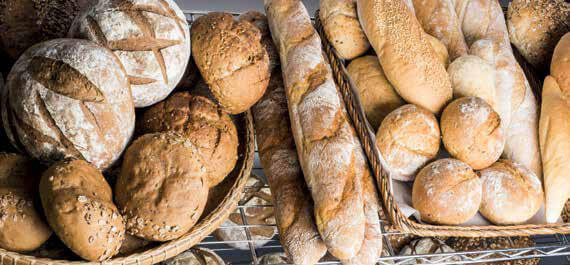Tough choice
“A jug of wine, a loaf of bread – and thou.” What a lovely line that is, what a soulful sentiment. Imagine that, captivated by its elemental sensuality, you decide to make it real – for just one evening, with your own personal “thou”. You can pick up the necessaries on your way home.
What sort of loaf should it be? Somehow, a white sliced doesn’t cut it, so you can rule out a few dozen variants there. Much the same goes for the “six seed” brown batch and the Hovis “half ’n’ half”.
A pain rustica might be nice, or a stone-baked boule or a classic garlic baguette. German vollkornbrot, Irish brown soda and San Francisco sourdough also make the shortlist. Or you could follow the online advice of those who have actually done this and specify a rosemary and sea salt flatbread, for its “emotional significance”. But let’s not rush here: it would be a shame not to at least consider the rye and poppyseed batch, mixed olive ficelle, soya and linseed ciabatta or sweet potato and goat cheese loaf. And you haven’t left the Waitrose bakery aisle yet.
What about the wine? The first, banal level of choice is four-way: red, white, rosé or some kind of sparkling. Let’s suppose you’re fortunate and “thou” has a definite preference for just one of these – red, perhaps. Phew.
OK – what’s right for the mood? The earthiness of merlot? The sensuality of shiraz? The complexity of cabernet sauvignon? What about provenance? Is this a moment for the refinement of Bordeaux, the richness of Burgundy or the softness of the Rhône? Why not a romantic Chianti or a proud Rioja? That’s before you’ve reached the “new world” section, with shelves of sumptuously described reds from California to New Zealand via Chile and South Africa.
This is getting tough. It was a simpler matter for Omar Khayyám, the Persian poet who was responsible for the lovely line in AD 1120. His would have been the local wine, the local bread – not the bewildering proliferation of options we have to contend with a millennium on.
 One of the greatest blessings of modern capitalism is also one of its greatest curses: the daily, hourly, minute-by-minute opportunity – and requirement – to exercise choice. There can be more than 60,000 products to negotiate in a single supermarket. Bread and wine are not one-tenth of it.
One of the greatest blessings of modern capitalism is also one of its greatest curses: the daily, hourly, minute-by-minute opportunity – and requirement – to exercise choice. There can be more than 60,000 products to negotiate in a single supermarket. Bread and wine are not one-tenth of it.
Choice is an area of human psychology that business academics have looked into closely, and the findings that emanate from their studies make for fascinating and – from a marketer’s viewpoint – awkward reading.
In their Journal of Personality and Social Psychology paper, Sheena Iyengar and Mark Lepper showed how superabundance has a paralysing effect. The study compared the results of presenting 24 or six jams in a special supermarket display. Shoppers were more likely to taste a jam in the 24-jar selection – but not to buy. Purchases were significantly higher when just six were offered.
Professor Simona Botti of London Business School has demonstrated the importance of “choice closure” to help consumers feel a sense of satisfaction and completion after a selection process – rather than the nagging doubt that they might have left something better behind.
In one study, Botti and her team showed people a tray of chocolates covered with a transparent lid. Half the group were invited to choose a chocolate and leave the lid off; the other half were asked to put it back on again after choosing.
Satisfaction scores were collected after people had eaten their chosen chocolate. Those who had put back the lid were happier with their choice than those who kept the tray open – less likely to think about the other chocolates they might have had instead, as though the act of replacing the cover had established closure both literally and emotionally.
Choice is far from simple and marketers make it more complex than they need to. Innovations come down the pipeline, but nothing drops off the other end. Ranges proliferate. Consumers baulk. Closure is ignored.
Whenever I work with teams on range rationalisation, I always get them to lay out the SKUs physically, on a table or the floor, rather than just look at a PowerPoint scheme. That usually produces gasps of surprise that there is so much, and agreement from everyone to narrow it down and delete. But guess what? It ain’t easy choosing.
So be prepared for a long, late session when you finally get round to making your runaway range more consumer-friendly and building in some closure cues. You might even want to send out for a takeaway. Hmm… Indian? Mexican? Chinese? Burger? Pizza…?
There is a wealth of academic papers and books for those who want to find out more:
The Art of Choosing (Sheena Iyengar, Twelve, 2010)
Iyengar is a professor at Columbia Business School and architect of the famous “jam” study. Her book embraces the psychological, social and biological motivations that influence choice.
The Paradox of Choice: Why Less is More (Barry Schwartz, Harper Perennial, 2004)
Why proliferation of choice is detrimental to our psychological and emotional well-being.
When Choosing is Not Deciding (Simona Botti and Ann McGill, Journal of Consumer Research, 2006)
Explores the impact of option differentiability on choice satisfaction.
Clash: 8 Cultural Conflicts that Make Us Who We Are (Hazel Markus and Alana Conner, Penguin, 2013)
Looks at how viewing choice as an expression of individuality is a peculiarly Western phenomenon.
Tragic Choices: Autonomy and Emotional Responses to Medical Conditions (Simona Botti, Sheena Iyengar and Kristina Orfali, Journal of Consumer Research, 2009)
Explores how we choose when in extreme situations of vulnerability.
The Business of Choice (Matthew Willcox, FT Press, 2015)
Why business needs to pay more attention to how customers make choices.
